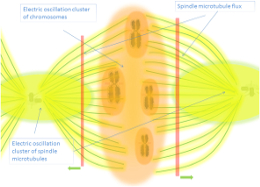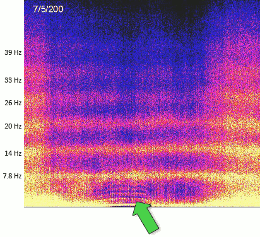

Electromagnetic Mind - Principal
Main theory and layers of a conscious field in different scales
How mind can be constructed from a variety of electromagnetic (EM) field layers? This is important question is answered following an a very integrative and experimentally based framework developed by a leading Indian-Japan team [1] and directly supported by various works [2,10,11] ...
As the authors write in the abstract of the cited work:
" Our hardware is a multilayered seed structure. If we open the largest seed, which is the final hardware, we find several computing seed structures inside, if we take any of them and open, there are several computing seeds inside. We design and synthesize the smallest seed, the entire multilayered architecture grows by itself. The electromagnetic resonance band of each seed looks similar, but the seeds of any layer shares a common region in its resonance band with inner and upper layer, hence a chain of resonance bands is formed (frequency fractal) connecting the smallest to the largest seed (hence the name invincible rhythm or Ajeya Chhandam in Sanskrit)."
Information is transferred (and life is information transfer [3]) in the form of electromagnetic resonance windows that effects over some biological structures altering their physical/mechanical conformation or movement, and that in turn alter the resonance band of the seeds that are directly on the outer or in the inner layer.
This is well explained by other authors in this description:
" Bandyopadhyay was inspired to design the fractal computer by studying the inside of neurons. He isolated individual microtubules and measured their resonance properties [53]. He found three distinct resonance bands in the megahertz range (figure 3). Microtubules are composed of tubulin proteins. Similarly, tubulin proteins resonate in three distinct frequency bands, but in the gigahertz range. Most intriguing, he found that interfacing with a single tubulin protein in one of these frequencies altered the resonant properties of the whole microtubule. When he measured large bundles, or networks, of microtubules, he found, yet again, a triple resonance band in the kilohertz range. Although not directly tested, these macroscopic resonance properties may orchestrate with resonant frequencies at the microtubule level. This model gives rise to a picture of biology as a fractal computer. Activity at any level will affect the entire system."
The authors of the theory also have built an organic jelly where in the vacant space between two energy levels of a given resonance band, new bands appears if zoom is made, in a Mandelbrot fractal mode. Making infinite logic table for computation (different from computers that have a finite state logic (made by 0 and 1).[4]
Experimental proofs that underpin this theory and the importance of the electromagnetic fields is found more recently, in [10] the authors use novel an advanced technologies in this case to visualize single resonating protein complex and the ultra-low power communication deep inside a living neuron cell, and they discovered electromagnetic binary streams, that acts as a communication in an electrically resonating protein complex, in the axon of a neuron whose membrane is resonating a bit later, concluding that:
" Electromagnetic resonance, does not express as a true resonance effect on its own, it regulates the other resonance behaviors as integrator."
In a companion paper by the same authors [11] they electromagnetically triggered electrical, mechanical, thermal and ionic resonant vibrations in a protein and they image live that a protein molecule adopts a unique configuration for each resonance frequency. And they also found that there's a collective dielectric coupling between the axon core, microtubules/actins and the proteins residing inside the neuron and that electromagnetic communication in the neuron precedes the ionic firing, so:
" A neural network is in reality a network of electromagnetic coupling."
The main idea of this website is that consciousness, mind or life (totally equivalent) correspond to the different electromagnetic fields that act over different biological structures in different layers, being his active part. When the space inside the analyzed system is filled with more and more layers of EM fields, gaining complexity, life gains complexity acquiring a self referenced mind, that is, consciousness. The more passive part corresponding to memory is achieved by matter itself with it's vibrations and conformations in different scales, there is a continuous interaction of the fields with the matter that result in computation.
There are various theories that can contribute with some concepts or ideas to this main theory [2], the hope of the author of this website is that some scientists to have the ability and interest to integrate the important parts (and maybe prove it experimentally like have start doing Bandyopadhyay, Sahu and colleagues [1,4,10,11]).
For example, in Goodman et al. [5] it's proposed that mind is composed by two interdependent systems, one electro-ionic (tangible) an the other a stable, structured and functional 3D compendium of variously inducing interacting EM fields, and they propose that white matter is not a chaotic mass of axons, but they are very ordered layers of axons crisscrossing at 90º to each other, where
" .. at the points at which cerebral axons cross, electron vortices may be engendered with spin direction and core polarity switchable by the very low levels of field and frequency changes.. A brain 3D EM matrix of such vortices may enable natural digital mechanisms analogous to magneto-electronic random access memories and processor."
Some developments of the Information Integration Theory (IIT) are more specific than others, Adman et al. have developed what they call Integrative Brain Theory (IBT) [6]:
" We claim that IBT gives a complete description of conscious meaning, motor response, and differences in basic sensory modalities at one moment in time. In this theory, the electromagnetic field effects (accompanying spatial patterns of neuronal activity) bind the processed information and serve as a medium of detection. A temporal relationship of these spatial field effects may engender an overall meaning of a perception. The linear polarization frequency is suggested to exist along the surface of cortical dendrites, and possibly differentiate the basic sensory modalities."
As is viewed in [12] brain endogenous EMFs play an important role in the global integrative actions of the brain, to be more specific in a more recent paper the authors propose that electromagnetic fields in the brain allow the integration and assemblage of the different kind of networks (neural networks, glial, extracellular molecular, and fluid channels networks) [13]. This have some reminiscences in other scales; in the intracellular (or to be more specific intraneuronal) world it has been found, as mentioned earlier, that the electromagnetic resonance triggers all other forms of resonances like mechanical, ionic, etc. [10], and underpin the idea that the really important thing are the electromagnetic fields as all the other interactions have dependencies on them.
As Roleau and Dotta wrote [7] biological systems have the potential to be influenced by subtle energies which are exchanged at atomic and subatomic scales as EM phenomena. These energy exchanges have the potential to manifest at higher orders of discourse and affect the output (behavior) of a biological system.
And there are many other ideas and experimental evidences that can be appended to this theory, one important theoretical construction is made by McFadden [8,9] where he
" .. identify fields as the only plausible substrate for encoding gestalt intrinsic information and argue that the binding problem of meaning can only be solved by grounding meaning in this field-based gestalt information."
" .. describe recent experimental evidence which demonstrate that synchronous neuronal firing does indeed have a functional role in the brain; and also that brain’s endogenous EM field is involved in recruiting neurones to synchronously firing networks."
For some authors like S. Pockett conscious electromagnetic fields must have some specific patterns and are launched by unconscious processes [14] but the theory defended in this website is more extensive taking into account first, the unicellular intelligence and consciousness [15] that must be based in the same basic principles that the 'consciousness in the brain' because similar complex specificities are not possible on so different scales and morphologies and secondly, the description made by B. Kastrup that all mental processes may in fact be conscious and that the appearance of unconsciousness arise from our dependence on self-reflective introspection for gauging awareness [16].
References:
Very related sections:
↑ text updated: 06/09/2018
↓ tables updated: 19/06/2023
Endogenous Fields & Mind
 EM Mind
EM Mind
Electromagnetic Mind Main Theory and directly related experimental results ║ Other important aspects and theories that can integrate in the Electromagnetic Mind Main Theory
.
.

























